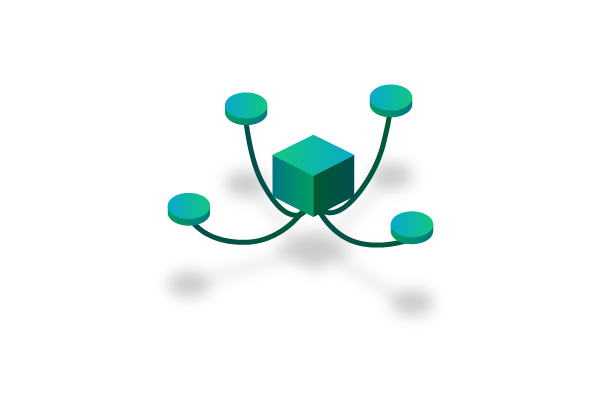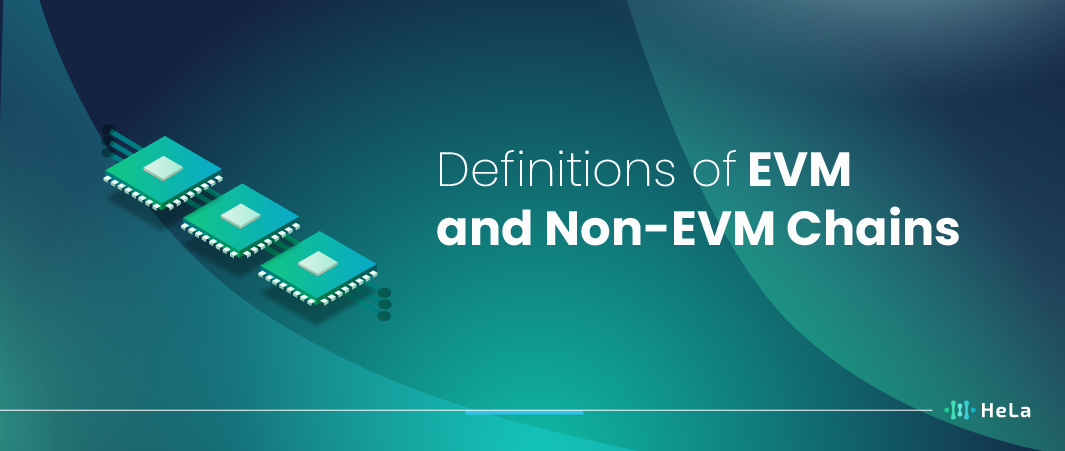In the dynamic realm of blockchain technology, EVM and Non-EVM Chains have emerged as pivotal players, transforming our digital landscape with decentralized solutions that empower both individuals and organizations. EVM Chains, represented by the Ethereum Virtual Machine, bring a unique set of characteristics to the table. On the flip side, Non-EVM Chains present their own distinct features that significantly influence their applications, scalability, and developmental aspects.
EVM Chains, powered by the Ethereum Virtual Machine, offer a decentralized framework that has become a cornerstone for various blockchain applications. However, as we explore the vibrant blockchain ecosystem, it becomes evident that Non-EVM Chains also play a crucial role. These alternative chains introduce diverse elements that cater to specific needs and preferences, contributing to the rich tapestry of blockchain possibilities.
Understanding the core differences between EVM and Non-EVM Chains is paramount in navigating the expansive blockchain landscape. Each variant comes with its strengths and limitations, shaping the trajectory of blockchain development and adoption. Whether it’s the robustness of EVM Chains or the tailored solutions of Non-EVM Chains, these two players collectively define the multifaceted nature of decentralized technology, influencing how we interact with and harness the power of the digital world.
What is an EVM Chain?
In the world of blockchain tech, an EVM Chain, or Ethereum Virtual Machine Chain, is like a buddy to Ethereum. It’s a kind of blockchain that follows the same rules as Ethereum, working like a sibling or close friend to the Ethereum network.
EVM Chains mainly use smart contracts to make transactions and create decentralized apps (DApps). This means developers can use the same principles and tools as Ethereum to build their DApps. HeLa, Ethereum, Binance Smart Chain, and Polygon are some well-known members of the EVM Chain club, each bringing its own unique features to the mix.
Comparing EVM and Non-EVM Chains, you can see they have different vibes. EVM Chains, as we mentioned, stick to Ethereum’s rules and are like cousins in the blockchain family. On the other hand, Non-EVM Chains are the rebels, doing things their own way. While EVM Chains collaborate and share tools, Non-EVM Chains have a unique group of developers adding to the diversity of the decentralized game.
In a nutshell, the difference between EVM and Non-EVM Chains is like having two flavors in the blockchain world. Each has its own style while playing the same decentralized game. This diversity not only sparks innovation but also gives developers and users various options based on their preferences and needs in the decentralized world.
Also Read: Blockchain Scalability: A Key Enabler for Web 3.0
Non-EVM Chains – A Different Approach
EVM and Non-EVM Chains represent two different approaches in the blockchain space. EVM Chains, like Ethereum, follow a specific model with their consensus mechanisms and programming languages. On the flip side, Non-EVM Chains take a different route, providing alternatives to the Ethereum-based system. These chains, including Solana, Polkadot, and Avalanche, stand out for their unique features, distinct governance structures, and scalability focus.
EVM and Non-EVM Chains diverge in their design philosophies, and this diversity benefits the overall blockchain ecosystem. Ethereum’s approach has set a standard, but Non-EVM Chains introduce innovation by addressing specific use cases and prioritizing scalability and interoperability. Solana, for example, emphasizes high-performance transactions, while Polkadot focuses on facilitating communication between different blockchains. Avalanche, on the other hand, stands out for its consensus protocol and ability to support custom blockchain networks.
In the rapidly evolving blockchain landscape, the coexistence of EVM and Non-EVM Chains provides users with a range of options to suit their needs. Whether developers prioritize Ethereum’s established model or opt for the unique features offered by Non-EVM Chains, this diversity fosters healthy competition and encourages continuous improvement in the blockchain space. As the industry advances, the collaboration and competition between EVM and Non-EVM Chains contribute to the ongoing evolution of decentralized technologies.
Key Differences in Consensus Mechanisms

One of the fundamental differences between EVM and Non-EVM Chains lies in their consensus mechanisms. Let’s discuss in detail their differences in consensus mechanisms and what makes them unique.
EVM Chains
Proof of Stake (PoS) and Proof of Work (PoW)
- Ethereum has historically used PoW but is transitioning to PoS for Ethereum 2.0.
- PoW involves miners solving complex mathematical problems to validate transactions and create new blocks.
- PoS relies on validators who lock up a certain amount of cryptocurrency to propose and validate new blocks, based on their stake in the network.
Energy Consumption
- PoW, as seen in Ethereum’s earlier version, is criticized for its high energy consumption due to the competitive nature of mining.
- PoS, the evolving consensus for Ethereum, is expected to significantly reduce energy consumption, making it more environmentally friendly.
Scalability
- Historically, PoW chains like Ethereum faced scalability challenges due to the time-consuming nature of block validation.
- PoS is anticipated to address scalability concerns by allowing for faster and more efficient block validation.
Non-EVM Chains
Delegated Proof of Stake (DPoS):
- DPoS is a consensus mechanism where a limited number of nodes, known as delegates or validators, are elected by the community to produce blocks.
- This mechanism aims to increase transaction speed and efficiency by reducing the number of nodes involved in the consensus process.
Directed Acyclic Graph (DAG):
- DAG is a different approach where each transaction is linked to multiple previous transactions, forming a graph structure without a fixed chain.
- Platforms like IOTA use DAG to improve scalability and eliminate the need for miners, allowing for faster and feeless transactions.
Transaction Speed and Throughput:
- Non-EVM Chains often prioritize faster transaction speeds and higher throughput compared to traditional blockchain systems.
- Novel consensus mechanisms like DPoS and DAG contribute to achieving these goals by optimizing the validation and confirmation processes.
Node Participation:
- DPoS typically involves a smaller number of elected nodes in the consensus process, which can enhance efficiency but raises concerns about centralization.
- DAG, by design, allows for a more inclusive participation of nodes, potentially reducing centralization risks.
The varied consensus mechanisms in blockchain platforms stem from their distinct approaches to addressing challenges like scalability, energy efficiency, and transaction speed. Each mechanism is chosen based on the specific goals and priorities of individual blockchain projects. The ongoing evolution of consensus models underscores the industry’s quest for optimal solutions that balance decentralization, security, and efficiency. Whether opting for Proof of Stake (PoS) to enhance energy efficiency or sticking with Proof of Work (PoW) for its proven security, blockchain developers continually navigate trade-offs to create systems aligned with their project objectives. Delegated Proof of Stake (DPoS) and Practical Byzantine Fault Tolerance (PBFT) cater to specific use cases, showcasing the adaptability and innovation inherent in blockchain ecosystems. As the industry matures, further refinements and novel consensus models are expected to emerge, reflecting the collective pursuit of scalable, energy-efficient, and secure decentralized systems.
Developer Ecosystem and Tooling

In addition to the extensive documentation and tutorials available for Ethereum, the developer ecosystem for EVM Chains is further enriched by a plethora of third-party tools and frameworks. These tools streamline the development process, providing developers with robust solutions for smart contract creation, debugging, and testing. The availability of widely-used programming languages, such as Solidity, enhances the ease of development and attracts a diverse community of developers.
Furthermore, the well-established nature of EVM Chains has facilitated the creation of comprehensive testing frameworks and security tools tailored specifically for smart contracts. This focus on security is crucial in the blockchain space, where vulnerabilities can lead to significant financial consequences. The Ethereum community, in particular, has been proactive in addressing security concerns, contributing to the overall reliability of EVM Chains.
As the developer ecosystem continues to evolve, there is a noticeable shift toward interoperability and collaboration between different blockchain platforms. Cross-chain development tools and protocols are gaining traction, allowing developers to create decentralized applications that can seamlessly interact with multiple blockchains. This trend is not exclusive to EVM Chains but is also observable in the emerging tooling support for Non-EVM Chains.
Non-EVM Chains are gradually carving out their space in the developer landscape, offering unique features and capabilities that differentiate them from their EVM counterparts. The growing developer community for Non-EVM Chains is fostering innovation and pushing the boundaries of what can be achieved with blockchain technology. Tooling support for Non-EVM Chains is expanding to accommodate the specific requirements and programming languages associated with these platforms, providing developers with a broader spectrum of choices.
Developers now find themselves at a crossroads, weighing the benefits of the well-established EVM Chains against the potential for innovation presented by Non-EVM Chains. The decision ultimately hinges on the specific use case, performance requirements, and desired features of the decentralized applications being developed. As the competition between these two ecosystems intensifies, it is likely to drive further advancements in tooling, interoperability, and overall blockchain development practices.
Also Read: Zero-Knowledge Machine Learning (ZKML)
Scalability and Interoperability

In the context of blockchain technology, scalability and interoperability are critical factors that influence the overall performance and adoption of a blockchain platform. Scalability refers to a blockchain’s ability to handle a growing number of transactions or users without compromising its performance, while interoperability pertains to the seamless interaction and communication between different blockchain networks.
The Ethereum Virtual Machine (EVM) and Non-EVM Chains represent two distinct approaches to addressing the scalability challenge. EVM Chains, such as Ethereum, often encounter issues like network congestion and high gas fees during periods of increased activity. These challenges not only affect the speed of transactions but also impact the overall user experience, making it less desirable for developers and users.
Non-EVM Chains, on the other hand, prioritize scalability and interoperability as core design principles. Solana, as an example of a Non-EVM Chain, has gained attention for its impressive throughput, capable of processing thousands of transactions per second. This high throughput translates to a more efficient and cost-effective experience for both users and developers, as it minimizes transaction delays and reduces associated fees.
Interoperability is another crucial aspect addressed by Non-EVM Chains. These platforms aim to establish compatibility with other blockchain networks, fostering a more interconnected and collaborative blockchain ecosystem. The ability to seamlessly transfer assets and data across different blockchains enhances overall efficiency and promotes a broader range of use cases for decentralized applications (DApps).
In summary, while EVM Chains struggle with scalability issues and high transaction costs, Non-EVM Chains like Solana focus on overcoming these challenges by prioritizing scalability and interoperability. This shift in emphasis reflects a broader industry trend toward building blockchain solutions that can support widespread adoption, accommodate increased transaction volumes, and facilitate seamless communication between diverse blockchain networks.
Conclusion
In conclusion, grasping the fundamental distinctions between EVM and Non-EVM Chains is essential for anyone navigating the dynamic world of blockchain. EVM Chains provide a user-friendly environment with a robust developer community, offering a sense of familiarity. On the other hand, Non-EVM Chains bring forth inventive solutions to address scalability and interoperability challenges. Choosing between EVM and Non-EVM Chains hinges on your project’s specific requirements, as each option boasts its own set of strengths. As we witness the ongoing evolution of the blockchain landscape, these disparities will play a pivotal role in shaping the future of decentralized applications and the broader blockchain industry. It’s crucial to stay well-informed and make thoughtful decisions to fully leverage the potential of blockchain technology.
Delving deeper into the intricacies of EVM and Non-EVM Chains, the former stands out for creating a comfortable space with a well-established developer ecosystem. It has become a go-to choice for projects seeking a supportive community and a sense of reliability. On the flip side, Non-EVM Chains emerge as pioneers, introducing innovative solutions aimed at enhancing scalability and facilitating seamless interaction between diverse blockchains. Navigating the choice between EVM and Non-EVM Chains ultimately boils down to understanding the unique needs of your project. In this rapidly evolving blockchain space, being attuned to these distinctions is paramount for making informed decisions that align with your project goals.
As we look ahead, the ongoing evolution of EVM and Non-EVM Chains will undeniably influence the trajectory of decentralized applications and the broader blockchain sector. Staying updated on these developments is not just advisable but integral to harnessing the full potential of blockchain technology. Whether you lean towards the familiarity of EVM Chains or opt for the innovative edge of Non-EVM Chains, your informed choices will undoubtedly shape the landscape of decentralized technologies in the times to come.
Disclaimer: The information provided by HeLa Labs in this article is intended for general informational purposes and does not reflect the company’s opinion. It is not intended as investment advice or recommendations. Readers are strongly advised to conduct their own thorough research and consult with a qualified financial advisor before making any financial decisions.

Joshua Soriano
I am a writer specializing in decentralized systems, digital assets, and Web3 innovation. I develop research-driven explainers, case studies, and thought leadership that connect blockchain infrastructure, smart contract design, and tokenization models to real-world outcomes.
My work focuses on translating complex technical concepts into clear, actionable narratives for builders, businesses, and investors, highlighting transparency, security, and operational efficiency. Each piece blends primary-source research, protocol documentation, and practitioner insights to surface what matters for adoption and risk reduction, helping teams make informed decisions with precise, accessible content.
- Joshua Soriano#molongui-disabled-link
- Joshua Soriano#molongui-disabled-link
- Joshua Soriano#molongui-disabled-link
- Joshua Soriano#molongui-disabled-link

